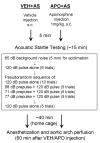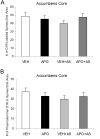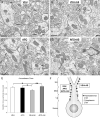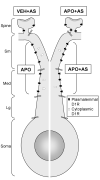Dendritic distributions of dopamine D1 receptors in the rat nucleus accumbens are synergistically affected by startle-evoking auditory stimulation and apomorphine
- PMID: 17490822
- PMCID: PMC1978178
- DOI: 10.1016/j.neuroscience.2007.04.005
Dendritic distributions of dopamine D1 receptors in the rat nucleus accumbens are synergistically affected by startle-evoking auditory stimulation and apomorphine
Abstract
Prepulse inhibition of the startle response to auditory stimulation (AS) is a measure of sensorimotor gating that is disrupted by the dopamine D1/D2 receptor agonist, apomorphine. The apomorphine effect on prepulse inhibition is ascribed in part to altered synaptic transmission in the limbic-associated shell and motor-associated core subregions of the nucleus accumbens (Acb). We used electron microscopic immunolabeling of dopamine D1 receptors (D1Rs) in the Acb shell and core to test the hypothesis that region-specific redistribution of D1Rs is a short-term consequence of AS and/or apomorphine administration. Thus, comparisons were made in the Acb of rats killed 1 h after receiving a single s.c. injection of vehicle (VEH) or apomorphine (APO) alone or in combination with startle-evoking AS (VEH+AS, APO+AS). In both regions of all animals, the D1R immunoreactivity was present in somata and large, as well as small, presumably more distal dendrites and dendritic spines. In the Acb shell, compared with the VEH+AS group, the APO+AS group had more spines containing D1R immunogold particles, and these particles were more prevalent on the plasma membranes. This suggests movement of D1Rs from distal dendrites to the plasma membrane of dendritic spines. Small- and medium-sized dendrites also showed a higher plasmalemmal density of D1R in the Acb shell of the APO+AS group compared with the APO group. In the Acb core, the APO+AS group had a higher plasmalemmal density of D1R in medium-sized dendrites compared with the APO or VEH+AS group. Also in the Acb core, D1R-labeled dendrites were significantly smaller in the VEH+AS group compared with all other groups. These results suggest that alerting stimuli and apomorphine synergistically affect distributions of D1R in Acb shell and core. Thus adaptations in D1R distribution may contribute to sensorimotor gating deficits that can be induced acutely by apomorphine or develop over time in schizophrenia.
Figures









Similar articles
-
Preferential relocation of the N-methyl-D-aspartate receptor NR1 subunit in nucleus accumbens neurons that contain dopamine D1 receptors in rats showing an apomorphine-induced sensorimotor gating deficit.Neuroscience. 2008 Jun 26;154(3):965-77. doi: 10.1016/j.neuroscience.2008.04.009. Epub 2008 Apr 12. Neuroscience. 2008. PMID: 18479834 Free PMC article.
-
Neurokinin-1 receptors in cholinergic neurons of the rat ventral pallidum have a predominantly dendritic distribution that is affected by apomorphine when combined with startle-evoking auditory stimulation.Neuroscience. 2008 Feb 6;151(3):711-24. doi: 10.1016/j.neuroscience.2007.08.039. Epub 2007 Dec 4. Neuroscience. 2008. PMID: 18178320 Free PMC article.
-
Deletion of the NMDA-NR1 receptor subunit gene in the mouse nucleus accumbens attenuates apomorphine-induced dopamine D1 receptor trafficking and acoustic startle behavior.Synapse. 2013 Jun;67(6):265-79. doi: 10.1002/syn.21637. Epub 2013 Mar 5. Synapse. 2013. PMID: 23345061 Free PMC article.
-
Chronic administration of morphine is associated with a decrease in surface AMPA GluR1 receptor subunit in dopamine D1 receptor expressing neurons in the shell and non-D1 receptor expressing neurons in the core of the rat nucleus accumbens.Exp Neurol. 2008 Apr;210(2):750-61. doi: 10.1016/j.expneurol.2008.01.012. Epub 2008 Jan 26. Exp Neurol. 2008. PMID: 18294632 Free PMC article.
-
Overlapping intracellular and differential synaptic distributions of dopamine D1 and glutamate N-methyl-D-aspartate receptors in rat nucleus accumbens.J Comp Neurol. 2005 Nov 28;492(4):442-55. doi: 10.1002/cne.20740. J Comp Neurol. 2005. PMID: 16228995 Free PMC article.
Cited by
-
Enhanced dendritic availability of μ-opioid receptors in inhibitory neurons of the extended amygdala in mice deficient in the corticotropin-releasing factor-1 receptor.Synapse. 2011 Jan;65(1):8-20. doi: 10.1002/syn.20810. Synapse. 2011. PMID: 20506149 Free PMC article.
-
Inhibition of p75 neurotrophin receptor attenuates isoflurane-mediated neuronal apoptosis in the neonatal central nervous system.Anesthesiology. 2009 Apr;110(4):813-25. doi: 10.1097/ALN.0b013e31819b602b. Anesthesiology. 2009. PMID: 19293698 Free PMC article.
-
Chronic desipramine treatment alters tyrosine hydroxylase but not norepinephrine transporter immunoreactivity in norepinephrine axons in the rat prefrontal cortex.Int J Neuropsychopharmacol. 2011 Oct;14(9):1219-32. doi: 10.1017/S1461145710001525. Epub 2011 Jan 6. Int J Neuropsychopharmacol. 2011. PMID: 21208501 Free PMC article.
-
The neurokinin-3 (NK3) and the neurokinin-1 (NK1) receptors are differentially targeted to mesocortical and mesolimbic projection neurons and to neuronal nuclei in the rat ventral tegmental area.Synapse. 2009 Jun;63(6):484-501. doi: 10.1002/syn.20627. Synapse. 2009. PMID: 19224600 Free PMC article.
-
Direct and indirect interactions of the dopamine D₃ receptor with glutamate pathways: implications for the treatment of schizophrenia.Naunyn Schmiedebergs Arch Pharmacol. 2013 Feb;386(2):107-24. doi: 10.1007/s00210-012-0797-0. Epub 2012 Sep 22. Naunyn Schmiedebergs Arch Pharmacol. 2013. PMID: 23001156 Free PMC article.
References
-
- Bakshi VP, Tricklebank M, Neijt HC, Lehmann-Masten V, Geyer MA. Disruption of prepulse inhibition and increases in locomotor activity by competitive N-methyl-D-aspartate receptor antagonists in rats. J Pharmacol Exp Ther. 1999;288:643–652. - PubMed
-
- Braff DL, Grillon C, Geyer MA. Gating and habituation of the startle reflex in schizophrenic patients. Arch Gen Psychiatry. 1992;49:206–215. - PubMed
-
- Brog JS, Salyapongse A, Deutch AY, Zahm DS. The patterns of afferent innervation of the core and shell in the “accumbens” part of the rat ventral striatum: immunohistochemical detection of retrogradely transported fluoro-gold. J Comp Neurol. 1993;338:255–278. - PubMed
-
- Carey MP, Diewald LM, Esposito FJ, Pellicano MP, Gironi Carnevale UA, Sergeant JA, Papa M, Sadile AG. Differential distribution, affinity and plasticity of dopamine D-1 and D-2 receptors in the target sites of the mesolimbic system in an animal model of ADHD. Behav Brain Res. 1998;94:173–185. - PubMed
Publication types
MeSH terms
Substances
Grants and funding
LinkOut - more resources
Full Text Sources
Research Materials

